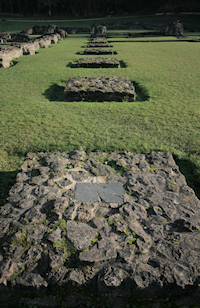Lesnes Abbey
Abbey ruins and ancient woodland
Lesnes Abbey and its woods, Abbey Wood
This page is under development. It should be finished in a few days’ … or weeks’ time.

Born c.1089, Richard de Lucy (or Luci) was a Norman nobleman who served as Henry II’s chief justiciar from 1154 until a few months before his death at the age of 90.
Excommunicated by Becket: 1166 & 1169.
In 1178 de Lucy founded Westwood Abbey on the Thames marshes west of Erith. According to most sources, he died here in 1179 and was buried in the Chapter House.
The abbey was dedicated to St Mary and Thomas Becket, who had been canonised just five years earlier
It is said by some that de Lucy founded the abbey as a penance for the murder of Thomas Beckett, though there is little evidence that he played a significant role in this xxx.
Augustinian order, though the abbey’s design … more Cistercian
building work seems to have continued until the 14th century
De Lucy bequeathed the abbey to Christ’s Hospital and it remained in their xxx until dissolution of the monasteries the first round of suppressions …
Rosesia was the great granddaughter of Sir Richard de Lici, and as a young girl she was raised at Lesnes Abbey and grew to love the place. She eventually married and moved away, becoming Roesia de Dover. However, when she died her heart was buried at Lesnes Abbey as a relic to be prayed for in order to speed the passage of her soul through purgatory.
with barns and fishponds
Edward I changed the name of the abbey’s from Westwood to Lesnes, a manorial name of unknown origin, though it may relate to an Old English word for ‘shelter’ or ‘refuge’.
This was never a wealthy institution, not least because it was encumbered with the cost of frequently repairing flood damage when the Thames inundated the marshes.
The monks were said to have been responsible for draining the marshes in the vicinity of the abbey
The abbey was suppressed by Wolsey as early 1524 or 25 … and most of the buildings were pulled down
The site was granted
described by Pevsner as “a useful diagram from which to learn the layout of monastic buildings”
… and in 1630 became the property of Sir John Hippesley, who commissioned an excavation that found xxx. fleur-de-lis (aka flower-de-luce), which may have been a rebus
The relics were said to have been reinterred, and a bay tree was planted near the spot. However, later excavations found no trace of them.
Henry VIII granted the abbey and its
Peasants’ revolt
Nineteeth-century authors speak of ‘the Abbot’s thorn’, an ancient tree that still stood in the grounds and may have been grown from a cutting taken from the Holy Thorn of Glastonbury.
Over the following centuries the abbey walls gradually disintegrated
Clapham 1909
but the remains were only laid bare in a second ‘campaign’ programme of excavation 1955–61?
footings
relics in the heritage musuem and the V&A
Lesnes Abbey Conservation Volunteers help the council look after the woods through the delivery of practical nature conservation events, such as hedge laying, coppicing, heathland restoration and wildlife surveys.
With the assistance of lottery funding, Bexley council built a new community hub called Lesnes Lodge in 2014–16. Its landscaped surroundings include the pleasing Monk’s Garden.

Lesnes Abbey, access via Abbey Road and New Road, London SE2
Phone: 01932 765328
Website: Lesnes Abbey Woods, also on Facebook
Bing bird’s eye view: Lesnes Abbey ruins (viewed from the north)
Open: always
Admission: free
Facilities: Limited light refreshments; books and souvenirs for sale at reception
Nearest station: Abbey Wood (National Rail) then a 5 minute walk

